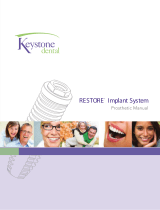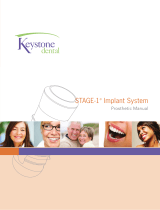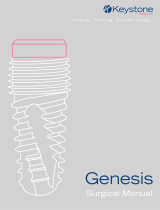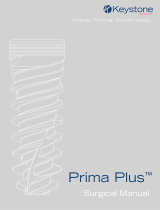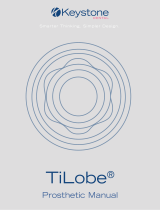7.3. Sterilisation
Read the instruction leaflet provided by the steriliser
manufacturer. Adhere to the space specified between
pouches and do not overload the steriliser.
- Only sterilise instruments which have previously been disinfected,
cleaned, lubricated and tested.
- Remove the rotating instrument from the torque wrench prior to
sterilisation. (See §6.1)
- Make sure that the device does not have any areas of corrosion or
cracks, and check that it is operating properly. Ensure that the product
is dry; if necessary, dry any residual water with medical quality pres-
surised air.
- Use sterilisation pouches suitable for the torque wrench and the
steriliser.
Always use one single torque wrench per pouch.
- In order to prevent any retention of water, place the pouch in the
steriliser in such a way that any concave parts are face down.
- If the steriliser has several types of cycle, choose a cycle designed for
medical devices (a minimum of 135°C at 2.13 bars (275°F at 30.88 psi)
for 18 minutes.)
- After each sterilization cycle, check that there is no water remaining
on the inside and outside of the packaging. Make sure that the flow
indicator has changed to the correct color.
- Keep the devices in the sterilisation pouches away from light, mois-
ture and any kind of contamination. Follow the manufacturer’s recom-
mendations as seen on the packaging.
- The duration for which the device is kept after sterilisation should not
exceed 1 month. Label the devices, specifying the expiration date.
After the expiration date, repeat the cleaning and sterilisation proce-
dure.
VIII. CALIBRATION
In order to maintain the precision of the torque values, it is recom-
mended that the torque wrench be returned for calibration every 2,000
uses or every 2 years.
IX. REPAIR
In the event of breakage, please contact your approved distributor or
the Anthogyr after sales service department directly.
All repairs must be carried out with parts and subassemblies
approved by the manufacturer.
Repairs must only be carried out by an approved distributor or by the
after sales service department in the factory.
For service or repair, the equipment must be returned complete and
sterile to the after sales service department. The equipment must be
sent together with a document stating the problem as well as the
complete name and address of the dentist.
For any claims to be considered under the guarantee, please enclose a
copy of the invoice or the delivery note with the equipment.
For every service or repair, send the complete torque wrench.
Replacement parts are available for 7 years beyond sales discontinua-
tion of the model.
E
D
E
g
Français
Deutsch
Español
Italiano
Português
Nederlands
中国的
English (US) English (UK)
X. GUARANTEES
This MD is guaranteed parts and labour against all manufacturing
defects for 12 months from the date of invoice.
This guarantee does not apply to wear and tear parts.
All changes or additions to the product without the express agreement
of Anthogyr render this guarantee null and void.
The guarantee becomes null and void if the technical instructions are
not followed.
Anthogyr cannot be held responsible for damage resulting from or
which could result from normal wear, use, cleaning or incorrect
maintenance, the non-observance of instructions for use or connec-
tion, scaling or corrosion, impurities in the water supply system or
unusual chemical or electrical influences or non observance of the
instructions, maintenance instructions and assembly of Anthogyr and
other manufacturer’s instructions.
Delivery charges incurred when sending an instrument back to Antho-
gyr for repair will be paid by the client, even if the repair itself is cov-
ered by the guarantee.
Postage and packing fees when returning the instrument to the client
are covered by the guarantee.
So that guarantee requests are taken into consideration, please attach
a copy of the invoice or a copy of the delivery slip to the MD.
XI. MEDICAL DEVICE REFERENCES
Description References
DYNAMOMETRIC C.A TORQCONTROL 15501
DYNAMOMETRIC C.A TORQCONTROL 15501-P
DYNAMOMETRIC C.A TORQCONTROL 15501S
XII. DISPOSAL OF THE PRODUCT
As far as is currently known, the product does not contain any sub-
stances which are harmful
to the environment. The product must be sterilised before being dis-
posed of. Observe national rules with regard to disposal.













